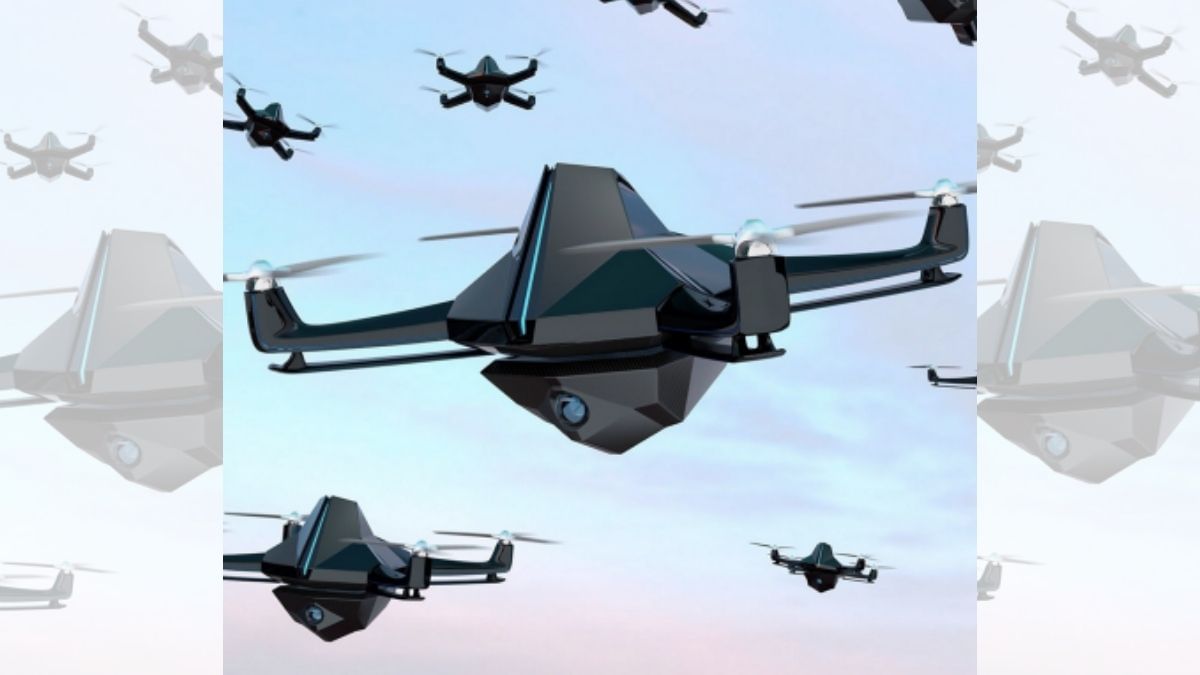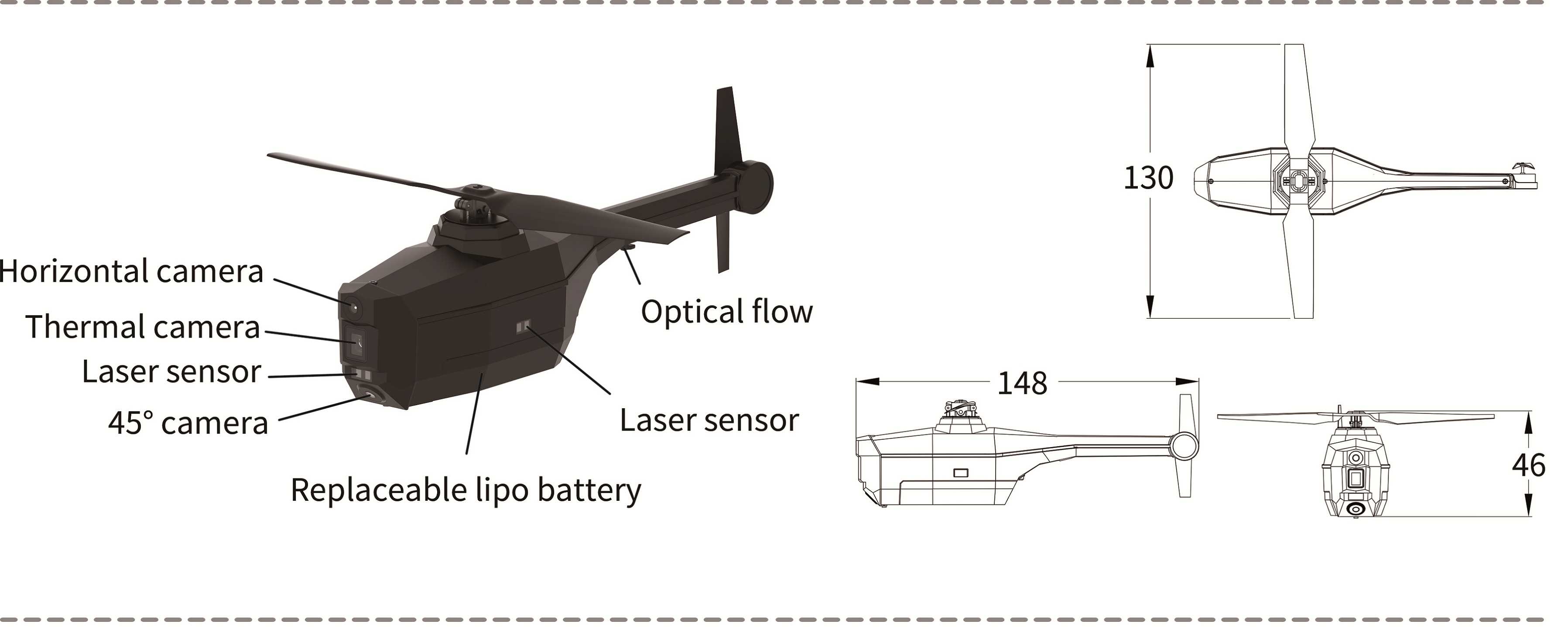Military Mini Drones - The Black Hornet Nano is a military micro unmanned aerial vehicle (PUA) developed by the Norwegian company Prox Dynamics AS and used by the armed forces of Norway, the United States, France, the United Kingdom, Germany, Australia, the Netherlands and Poland. , New Zealand, India, Turkey, South Africa and Algeria.
The drones are about 16 × 2.5 cm (6 × 1 in) in size and provide ground troops with information about the local situation. They are small enough to fit in one hand and weigh 18 g (0.7 oz) including batteries.
Military Mini Drones

The aircraft is equipped with a camera that provides the operator with video and images. They were developed as part of a £20m contract with Marlborough Communications Ltd for 160 units.
China Werkt Aan 'killer Drone' Die Gericht Doelen Kan Uitschakelen
An operator can be trained to fly the Black Hornet in 20 minutes. It has three cameras; one looking straight, one looking down, and the other looking down at a 45 degree angle. The Black Hornet suite has two helicopters and reaches 90% power in 20–25 minutes, about the same time as its hover time, with one ready to charge while the other is ready to fly.
In October 2014, Prox Dynamics introduced a version of its PD-100 Black Hornet with night vision capability, long-wave infrared and daytime video communication, capable of transmitting high-resolution video or images over a digital data link with a range of 1.6. km. (1 mile) distance. As of 2014, over 3,000 Black Hornets have been delivered.
The plane was used by soldiers of the British intelligence brigade at Camp Bastion in Afghanistan.
Operation Herrick personnel in Afghanistan deployed a Black Hornet from the front lines to fly into enemy territory to capture video and images before returning to the operator. Disarmed in 2016/2017.
U.s. Soldiers To Get Pocket Sized Drones By 2018
Designed to stay close to the dirty gray walls in Afghanistan and able to fly for 20 minutes on quiet electric motors, it was used to look around corners or walls and other obstacles to detect any hidden threats and enemy positions. The Black Hornet is connected to the operator via digital data transmission and GPS. The images are displayed on a small handheld terminal that can be used by the operator to control the UAV.
The Black Hornet is launched from a small box that can be attached to a service belt, which also stores the transmitted data, since the drone itself does not store any data, which is an advantage during a raid. Operators can control the drone or set distances so that it can fly on its own.
L ISR) program. It concluded that additional improvements are needed for the US military's role, including reconfiguring communications, providing night vision and improving navigational capabilities.

Although the Army is considering the mini-UAV for use by individual units as part of the Soldier Borne Services (SBS) program, the privately-built Black Hornet is considered too expensive for large-scale deployment, costing up to US$195 per unit. 000. The British Army has bought 30 "Bug nano-drones" to spy on targets up to 2km (1.25 miles) away, marking the military's latest move to use controversial unmanned aerial vehicles (UAVs).
Turkish Army Receives 1st Domestic Multi Rotor Mini Uav
The drones are small enough to fit in the palm of your hand and weigh 196 grams, about the size of a large smartphone.
Drones are used by armed forces around the world as surveillance equipment or high-altitude drones equipped with weapons. Their use has been heavily criticized by human rights groups, and the US and Turkey are among the countries that use drones to kill enemies outside their borders. The EU and Britain plan to use high-altitude drones to detect refugees and migrants in the Mediterranean and the English Channel.
However, the increasing capabilities of small drones that are widely available to retail consumers have led to their widespread use for monitoring in civilian and military situations. At the same time, the lack of regulations governing their use has also raised questions about how they are actually used by the armed forces.
Chris Cole, director of the independent organization Drone Wars, said: "Drone warfare is evolving in a number of ways, including the proliferation of nanosurveillance drones, such as these new Beetle drones, by private military units. Such systems, however, provide only very limited intelligence. can and may provide ground units with a false sense of security and situation.
Baykar Bayraktar Mini Uav
"In the past, we've seen commanders order airstrikes and other lethal actions based on remote sensing information, misunderstanding the situation on the ground and causing civilian casualties."
The British Army's new nano-drones have been launched by British arms manufacturer BAE Systems in partnership with Gloucestershire-based small military drone developer UAVtec. The drones have a 40-minute battery life and have the ability to stream live video to their controller.
The makers say the drone can withstand winds of up to 50 miles per hour and was able to withstand "unforgiving weather" in a recent military test conducted by the Department of Defense.

Last year, the Ministry of Defense announced it had spent £66 million on battlefield robotics projects, including similar surveillance 'mini-drones', as well as remotely piloted combat vehicles and self-driving logistics vehicles.
Pdf) Taking Drones To The Next Level: Cooperative Distributed Unmanned Aerial Vehicular Networks For Small And Mini Drones
Some autonomous equipment has been deployed in Iraq and Afghanistan, and the head of Britain's armed forces said last month that robots could form a significant part of the army by 2030.
James Gerrard, Chief Technologist, Applied Intelligence, BAE Systems, said: “Even in the worst weather, the Bug can operate autonomously to provide soldiers with visual updates, providing critical tactical intelligence about what's around the corner or over the next hill.
"Along with our other information advantages, this video feed can be distributed across multiple domains, allowing ground, sea and air commanders to increase situational awareness and justify their decisions." Mini drones are used by the military to spy on terrorists. Inside Ministry of Defense buildings Credit: The /Geoff Pugh
As part of a new multimillion-dollar investment, the Department of Defense has announced that mini drones will be used by the military to spy on terrorists inside buildings.
Us Army Considering Israel's Firefly Mini Drone
As part of a £66m investment in military robotics projects, troops will be equipped with tiny eyes in the sky to defeat enemies.
The Defense Secretary said £31m would be spent on pocket-sized drone cameras to help troops operate safely in difficult terrain.
Systems will also be developed to control armored vehicles by remote control, and autonomous logistics trucks will be developed to free soldiers from dangerous resupply duties.

Money for the new projects will come from the £160m Transformation Fund announced by the Ministry of Defense last year. The announcements outline how the Department of Defense plans to integrate technology into military service in the future to take advantage of the rapid pace of technological change.
How Drones Have Added A New Dynamic To Conflicts
Defense Secretary Gavin Williamson said: “Innovation means nothing if we don't move great ideas from the drawing board to production and to the front line faster than ever before.
"In an increasingly dangerous and deadly era, the Department of Defense is not waiting for inspiration. We are taking the opportunity to step up."
The investment comes on the heels of 2018's largest robotics exercise the Army has ever conducted and the Autonomous Soldier exercise, an example of what the Defense Department calls "prototype warfare."
Army Commander General Sir Mark Carlton-Smith said: "Rapid adaptation is a critical component to success on the battlefield."
British Army Recruits 30 Nano 'bug' Drones As Battlefield Spies
Major General Chris Tickell said the army would become an "incubator of innovation". Active duty soldiers are provided with new test equipment, kits are increasingly purchased from commercial sources and are designed for rapid replacement.
The new mini-drones weigh less than 200 grams each and can be launched from the palm of a soldier's hand.
The Army understands that each drone can cost thousands of pounds. Similar opportunities on the market today are ten times more expensive.

Small planes provide day-and-night cameras so soldiers can see inside buildings and around the battlefield from relative safety. Similar devices have been successfully tested in Afghanistan.
Black Hornet Nano
A £23 million remote control project for the Army's combat vehicles. This allows mechanized vehicles such as the Warrior infantry fighting vehicle to outrun troops into areas believed to be covered by enemy guns or explosives.
£12m will be spent on robotic logistics vehicles. It is very difficult to design resupply platforms that know where to go without relying on satellite navigation systems that the enemy can detect.
Availability of front-line troops to organize resupply
Small military drones, flying drones military, military drones for sale, best military drones, armed military drones, military unmanned drones, military drones pictures, new military drones, mini military drones, drones military, drones for military, who makes military drones

0 Comments